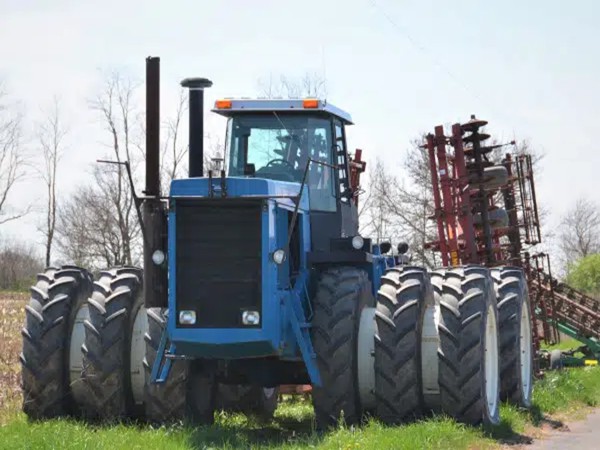Farm Tractor Tire Guide & Size Conversion Chart
April 25, 2021
Keeping your tires in good shape will improve your productivity and reduce your fuel consumption.

How do I maximize the life of my tractor tires?
Tires over time will age and wear down. The following tips will help you get the most out of your tires:
- Check tire pressure: Properly inflating your tires is very important to maximize service life. When a tire is underinflated, it can cause excessive wear. Follow manufacturer specifications and ensure your tire pressure is in line with guidelines. Check your tire pressure on a regular basis since changing temperatures can raise and lower tire pressure naturally.
- Regular inspections: Check the sidewalls and treads every month to monitor the overall condition. Look for cracks, discoloration, bulges, wear or additional unnatural blemish. You might be able to catch issues early.
- Store your tractor indoors: Exposure to sunlight UV will damage your tire over time and shorten its lifespan.
- Clean your tires: Clean and wash your tires after use. You can use light dish soap in the water without causing an issue.
- Avoid harsh chemicals: Petroleum-based products may degrade your tire, so read labels of any products you use.
- Avoid overloading: Follow manufacturer guidelines and avoid operating with excessive weight for prolonged terms.
When should I replace my tractor tires?
As tractor tires wear down, you may notice performance and productivity declines. This can result in higher fuel consumption and lost time because energy is lost when the tire slips or loses traction. When your slip starts to increase, then it is often a sign you should consider replacing your tractor tires.
The frequency at which you should replace your tires depends on your local climate. Wetter regions tend to require more frequent tractor tire replacement than dryer regions.
If you start to see cords, then the tire needs to be replaced immediately. Sometimes damaged tires can be repaired — if your tire was damaged, you might be able to save money by having it repaired rather than replacing it. Each instance is different, so it is best to speak with a qualified service person.
Who makes farm tractor tires?
The largest manufacturers of farm tractor tires include Goodyear, Titan, Carlisle, and Advance. Titan International is one the largest off-highway tire manufacturers, selling tires under the Titan and Goodyear brand names.
How do I read my tractor tire size?
Tractor tires come in many shapes and sizes. When you change your tires, you should check your existing tires and make sure your new tires will fit properly. Tractor tires use three different formats: Standard, Radial and Metric.
An example of tractor tire size expressed in Standard format would be “20.8-42”. The “20.8” means the tire is 20.8 inches wide and the “42” indicates the tire fits a 42-inch diameter wheel. The dash “-” indicates the tire construction is bias-ply (an "R" would be used if the tire were radial).
Tractor tire sizes are stated in Standard (Imperial measurement, inches), Radial, and Metric (millimeters) Sizes. You should first establish which measurement your tire uses, and then you can use the chart below to reference the tire size you need.
Tractor tire size conversion chart for Standard, Radial and Metric
We have included a basic tire conversion chart below. To convert from metric to imperial (millimeters to inches), you can divide the number by 25.4 to get the inches equivalent. To convert from imperial to metric, multiple by 25.4 to get the millimeter equivalent.
| Standard Size | Radial Size | Metric Size |
| 11.2X20 | 11.2R20 | 280/85R20 |
| 12.4X20 | 12.4R20 | 320/85R20 |
| 9.5X24 | 9.5R24 | 250/85R24 |
| 11.2X24 | 11.2R24 | 280/85R24 |
| 12.4X24 | 12.4R24 | 320/85R24 |
| 13.6X24 | 13.6R24 | 340/85R24 |
| 14.9X24 | 14.9R24 | 380/85R24 |
| 16.9X24 | 16.9R24 | 420/85R24 |
| 18.4X26 | 18.4R26 | 420/85R26 |
| 11.2X28 | 11.2R28 | 280/85R28 |
| 12.4X28 | 12.4R28 | 320/85R28 |
| 13.6X28 | 13.6R28 | 340/85R28 |
| 14.9X28 | 14.9R28 | 380/85R28 |
| 16.9X28 | 16.9R28 | 420/85R28 |
| 14.9X30 | 14.9R30 | 380/85R30 |
| 16.9X30 | 16.9R30 | 420/85R30 |
| 420/90R30 | ||
| 18.4X30 | 18.4R30 | 460/85R30 |
| 12.4X32 | 12.4R32 | 320/85R32 |
| 12.4X34 | 12.4R34 | 320/85R34 |
| 14.9X34 | 14.9R34 | 380/85R34 |
| 16.9X34 | 16.9R34 | 420/85R34 |
| 18.4X34 | 18.4R34 | 460/85R34 |
| 20.8X34 | 20.8R34 | 520/85R34 |
| 12.4X36 | 12.4R36 | 320/85R36 |
| 13.6X36 | 13.6R36 | 340/85R36 |
| 13.6X38 | 13.6R38 | 340/85R38 |
| 14.9X38 | 14.9R38 | 380/85R38 |
| 16.9X38 | 16.9R38 | 420/85R38 |
| 18.4X38 | 18.4R38 | 460/85R38 |
| 20.8X38 | 20.8R38 | 520/85R38 |
| 18.4X42 | 18.4R42 | 460/85R42 |
| 20.8X42 | 20.8R42 | 520/85R42 |
| 20.8X46 | 20.8R46 | 520/85R46 |
Source: Ken Jones Tires
Resources
Tractor tire tread options
Preventing tire dry rot



